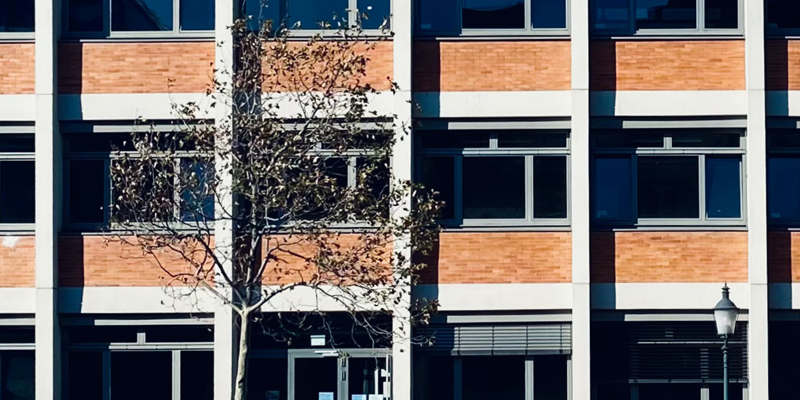
RAAC concrete crisis—issues to consider for use of porta cabins and temporary use of other buildings
Real estate Partner, Alex Ground, sheds a light on the complex issue of dealing with Reinforced Autoclaved Aerated Concrete (RAAC) in public buildings, offering insight into the planning considerations, including the use of portable buildings and temporary use of other buildings to tackle the urgent crisis.
The discovery of the hazardous concrete material, RAAC, in school buildings has prompted partial closures by the Government. This has necessitated schools, as well as potentially other public facilities such as healthcare institutions and courts, to hastily devise contingency measures.
What is RAAC?
RAAC is a lightweight, bubbly form of concrete that was frequently used in the construction or modification of public buildings between the 1950s and mid-1990s. It is usually found in roofs and occasionally in walls and floors. The issue with RAAC is that it is weaker than traditional concrete and in many cases it has now passed its estimated 30 year design lifespan.
What are the solutions?
It may take anywhere from weeks to over a year to replace the RAAC. There are two options that may offer an interim solution whilst works are carried out to replace the RAAC:
- portable accommodation or;
- using other existing buildings made available, which currently have a different lawful use.
Depending on the specific circumstances, the need for planning permission may be bypassed for either option, therefore providing a practical alternative to delivering in-person facilities promptly.
Why are portable buildings a convenient solution?
Rather than reverting to online strategies developed during the COVID-19 pandemic, schools (and other public service buildings) may want to consider using portable buildings as an alternative.
While the erection of buildings and structures usually requires planning permission, there are various exceptions that mean certain portable buildings will not require planning permission, saving time and resources.
Planning permission for portable buildings
Firstly, some portable buildings may not constitute a building, and thus don't fall within the definition of a development and trigger the requirement to obtain planning permission. Whether or not a portable building is classed as a building is a grey area. The courts have developed a three-fold test by reference to the size of the structure, degree of permanence, and degree of physical attachment in determining whether a structure is a building. Larger and more permanent portable buildings that are physically attached to the land are more likely to require planning permission compared to small and less permanent ones that are more readily moveable.
Most appeal decisions considering the issue, have found porta cabins to be a ‘building’ that requires planning permission (or permitted development rights – see below). However, there are a couple of appeal decisions, where it was held that the porta cabin was not a building, and therefore it only needed to be considered if a material change of use of the land was proposed (if playground land that is already being used as part of the school is the site for the portacabin then unlikely that would be a material change of use of the land).
Once you have details of size, how the porta cabin will be put into place, services etc. full advice on the issue of whether it even needs planning permission can be given. There is a formal process whereby you can apply to the local planning authority to seek formal confirmation that proposed works do not amount to development: a Certificate of Proposed Lawful Development. However, these often take several weeks so may not suit all urgent circumstances.
Permitted development rights
Secondly, certain portable buildings may not require planning permission even where they are found to be a building. This is because the Town and Country Planning (General Permitted Development) (England) Order 2015 (SI 2015/596) (GPDO 2015) gives deemed planning permission for certain developments without the developer having to make a formal application for planning permission. This is commonly known as ‘permitted development’.
Fortunately, in the context of the RAAC crisis, there are some permitted development rights that may assist which include:
- Class B, Part 4 of Schedule 2 to the GPDO 2015 which permits a moveable structure and the temporary use of any land for up to 28 days in any calendar year (of course this will only help where fixing the RAAC issue can be done quickly).
- Part 7, Class M of the GPDO 2015 allows for the erection of school buildings on existing school sites, subject to certain parameters.
- Part 4, Class C allows for the use of any building and any land within its curtilage as a state-funded school for two academic years.
- Part 4, Class CA allows for the provision of temporary school buildings on vacant commercial land for up to three academic years.
Can you change the use of some buildings or land on a temporary basis?
Another option to create new educational (or any other use) space is to ‘change the use’ of existing buildings/land.
The Town and Country Planning (Use Classes) Order 1987 (as amended) (the Order) puts uses of land and buildings into various categories known as 'use classes'. Depending on the specifics of any proposed change of use it may require an application for planning permission or prior approval.
Helpfully, under the GDPO 2015, the use of a building and any land within its curtilage can be changed from one of the uses specified below to use as a state-funded school falling within Class F.1 (a) of Schedule 2 to the order through a process called deemed development so long as various conditions are met and an application is made to the Local Planning Authority (LPA) to determine whether prior approval will be required. These uses include:
- Class C1 (hotels)
- Class C2 (residential institutions)
- Class C2A (secure residential institutions)
- Class E (commercial, business and service)
- Agricultural buildings
Other relevant permitted development rights that may assist include Class CA Part 4 for provision of a temporary state school on previously vacant commercial land for up to 3 academic years.
If you’re dealing with a different required use, then it is possible there are other permitted development rights that may assist.
What are the planning enforcement risks?
Given the urgency to get new portacabins in situ and depending on the size of the same, it may be decided to go ahead and get them installed ahead of obtaining a Certificate of Lawfulness or planning permission. Should you do this and the LPA take a different view as to whether planning permission was needed that portacabins would be unlawful. However, until such time, if any, as the LPA actually took enforcement action and any date for compliance was not adhered to, no criminal offence occurs.
It is also important to remember that even if the LPA decided planning permission was required (and had not been obtained) LPAs have discretion whether or not to take planning enforcement action. Indeed, on 8 September 2023, the chief planner wrote a letter to LPAs asking that they take a pragmatic approach to accommodation at schools due to RAAC, including the need for concurrent and retrospective applications. Having a discussion with the LPA may bring the comfort required as it would be hoped most LPAs would want to be as helpful as possible in this situation.
If there was any planning enforcement action, this would most likely be in the form of the LPA issuing a planning enforcement notice requiring the removal of the portable building or to cease using a building. Failure to comply with an enforcement notice which has taken effect can result in prosecution and/or remedial action by the LPA.
RAAC crisis: solutions and implications
The process to remove RAAC, supply temporary accommodation and restore facilities in more than 150 schools and numerous other public buildings is without a doubt going to be a costly process. Portable classes and changes of use of other nearby buildings are two cost effective solutions (from a planning perspective) that schools may be able to implement quickly to address the temporary or permanent closure of buildings.
The RAAC crisis will have long term impacts and we expect LPAs to take a far greater forensic consideration of the lifespan of proposed buildings in planning applications and building materials. This will undoubtedly tie in with sustainability policy, possibly adding to the already hefty costs faced by developers. We expect to see these changes reflected in new local plans shortly.
Get in touch
If you would like to speak with a member of the team you can contact our real estate planning and construction solicitors; Holborn office (Email Holborn) +44 (0)20 3826 7523; Kingston office (Email Kingston) +44 (0)20 3826 7518; Putney office (Email Putney) +44 (0)20 3826 7518 or complete our form.




